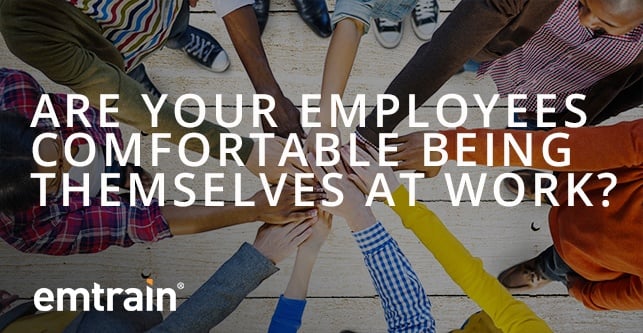Did you know that 83% of LGBT employees feel the need to downplay or hide their sexual orientation in the workplace to avoid judgment?
Sure, we all need to have boundaries with our personal and professional lives, however studies show that hiding our true selves can be crippling to our careers.
A Deloitte report revealed that 61% of all employees hide or “cover” their identities in some way. This can look different for specific diverse populations.
For example, a working mother may not mention her children in fear that her colleagues won’t think she’s dedicated to her career. A gay man may not put up photos of his husband because he doesn’t want to make anyone uncomfortable. A straight white man might not mention the mental health issues he’s facing.
This workplace habit of covering can negatively impact employee engagement and performance because employees spend more time thinking about hiding parts of themselves rather than on their work.
In their HBR.org article, Dorie Clark and Christie Smith mention a few ways you can encourage employees to feel free to be themselves in the workplace:
1. Shift the language
Unfortunately, when we use the term “diversity” in workplace conversations, most people will tune out. That’s because most people don’t think the term applies to them.
To make the concept more relatable, use language like “covering.” Covering is another way to describe the act of downplaying certain personal attributes (sexual orientation, health issues, family/marriage status) to avoid judgment or feeling different.
When we use more universal terms like that, it can make everyone feel included, since most people have downplayed something about themselves at work.
2. Share Your Story
Leaders are in a unique position to share their stories to show that it’s safe to share and embrace our differences. In the article, Christie Smith talks about sharing her story of being a survivor of the 9/11 attacks. She shared the hardship she dealt with and overcame, making it safe for others to share their experiences.
Diversity comes in many shapes and sizes. Help your employees feel welcome and safe to be different by modeling it by example.
3. Embrace analytics
Use Emtrain Intelligence to track diversity by age, gender, race, disability, mental health, and other different “slices” in each department to make sure you are granting opportunities fairly.
4. Encourage the conversation
Create a culture where people feel comfortable discussing personal challenges and feelings of exclusion with managers and colleagues. Managers need to make employees feel seen and heard and upper management needs to support their efforts by building inclusion into performance reviews and into the corporate vernacular.
5. Look beyond the obvious
Everyone has unique personal quirks they bring to the office. Of course, most of the discussion surrounding diversity refers to age, race, gender, etc., but the more you talk about diversity in a broader sense, the more people will get on board with the importance of fostering an inclusive culture.
Conclusion
You can’t have diversity without inclusion. Use the tools at your disposal to encourage inclusion and communicate with your teams when you hear that others are feeling the need to “cover” for any reason.











